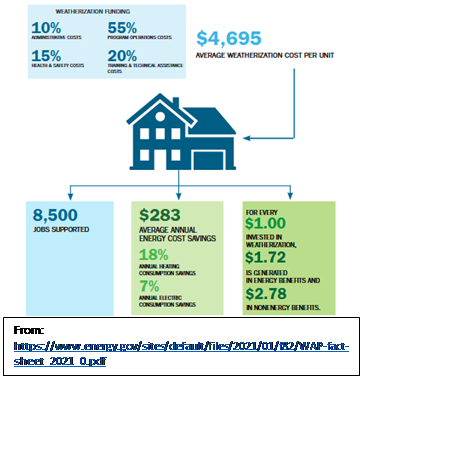

By Erin Cosgrove | Mon, November 21, 22
Welcome to the newest installment of a new blog series called Turning Policy into Performance. In this series, we'll take a look at how states can implement decarbonization and climate goals with energy efficiency programs.
On October 21, 2022 the U.S. Department of Energy provided guidance for WAP recipients to include two non-energy impacts (NEI) in the cost-benefit analysis – the social cost of carbon (SCC) and water usage reduction. These new additions will expand measures allowed under WAP and shift the program to consider energy benefits plus decarbonization benefits of a measure.
What is WAP
The weatherization assistance program (WAP) helps low-income home owners by providing energy efficiency improvements in the home, such as insulation and air sealing; heating, ventilation, and air conditioning systems; lighting; and appliances. These services are delivered around the country by community action agencies, nonprofits, and local governments.
When contractors assess a home, they analyze the options available to homeowners based on the cost-effectiveness of each individual measure. This results in a limited number of measures available to customers because each conservation measure must be individually cost-effective, based on energy savings alone. The narrow focus of current cost-benefit analysis ignores the environmental, economic, and health impacts these improvements have and becomes an obstacle to implementing programs that target energy savings and address equity barriers.
Valuing non-energy impacts (NEIs) is especially important with WAP because while WAP is intended to provide lower energy costs, evaluations of the programs have found that other benefits provided by the programs are even greater, including improvements in health and comfort in the home. In fact, Oak Ridge National Lab found that if health and other non-energy impacts (NEIs) are included in cost-benefit, a weatherization project could result in four times the benefits of the initial cost of the project.
Advantages of Including NEIs in Cost-Benefit Analysis
Including non-energy impacts (NEIs) expands available program offerings because it values that would normally go unaccounted for. For WAP, including the social cost of carbon and water usage will expand available measures as it allows for individual measures that may provide lower energy savings but also include water and carbon savings to be utilized by contractors. Accounting for water reduction encourages the implementation of low-flow devices such as faucet aerators and showerheads, which reduce hot water usage. Pricing carbon encourages energy efficiency measures that result in deeper savings, such as fuel switching and weatherization, by recognizing the economic benefits that come from reducing carbon in the atmosphere. Additionally, including NEIs in the cost-benefit analysis is important because it would alleviate the higher cost that typically deters investment. While WAP is more costly to implement than other programs, it provides exponentially more benefits. Accounting for the full benefits of the programs will allow the real value of them to be assessed.
The social cost of carbon is particularly important because it internalizes the cost of our energy systems by estimating future environmental and social damages caused by a metric ton increase in carbon dioxide emissions both inside and outside the home. This calculation represents the numerous impacts of climate change, including changes in agriculture production, changes in health outcomes, sea level rise and property damage, changes in energy consumption, and declines in labor productivity. Additionally, it can encourage electrification by accounting for the emissions of fossil fuels that may have not been considered but for the inclusion of the SCC. Electrification makes homes healthier and affordable by removing the indoor combustion of fossil fuels.
Conclusion
The social cost of carbon is a powerful metric that serves to account for all impacts of carbon emissions on society. Considering non-energy impacts alongside energy usage will expand our definition of cost-benefit to shift programs towards more equitable outcomes. Including the SCC in the cost-benefit analysis for WAP installation measures helps to acknowledge the societal benefits of the program and holds the energy industry accountable for its carbon emissions. This change will create positive impacts through embedding climate goals, accelerating market transformation, and addressing environmental inequities.

